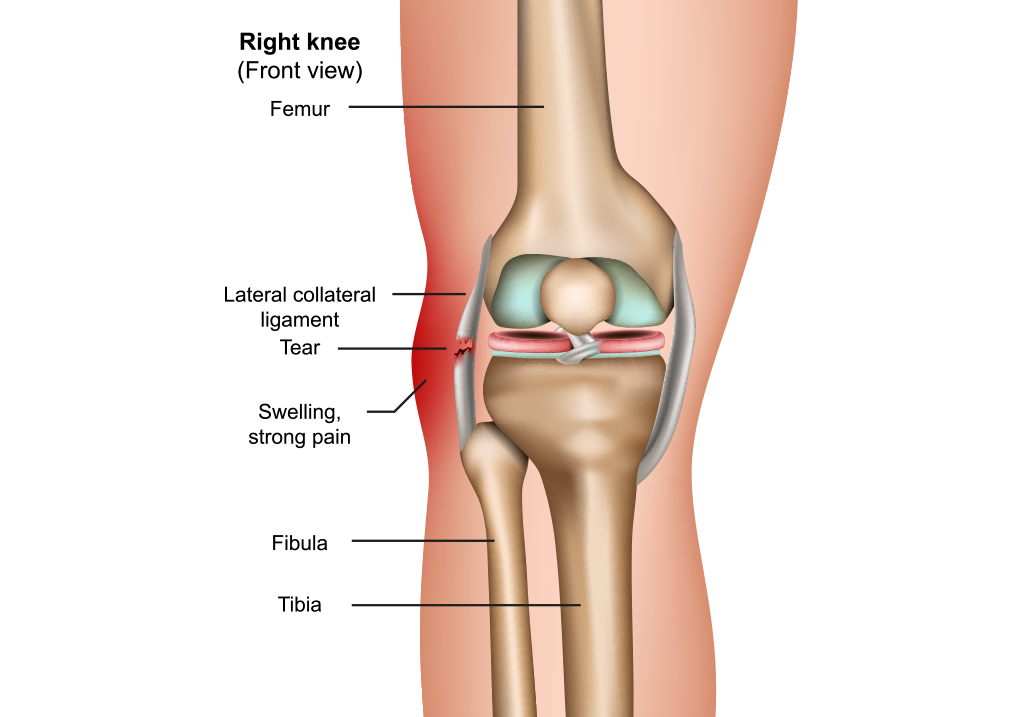A Meniscus Injury is any damage to this cartilage disc, sometimes referred to as a cartilage tear. Meniscus tears are the most common type of knee injury, which can be a partial tear, or larger total tear.
Particularly at risk are athletes, as well as those who are older or over weight.
These injuries can happen suddenly (acute) or over a sustained period of time due to degradation and repetitive actions.
Tears are diagnosed by their appearance as well as location. Common types include bucket handle, flap, and radial tears.
An acute injury is caused by a forceful twisting action of the knee, such as a quick rotation of the upper leg while the foot is planted. Repeated or prolonged squatting can also cause injury.
Injuries sustained from sports are often coupled with other knee injuries, like anterior cruciate ligament (ACL) tears.
Degenerative Meniscus injury is usually caused by age-related degradation or pressure from carrying excess body weight. In which case, a lesser movement could cause the Meniscus to tear.
Symptoms of an acute injury will be more obvious than degradation.
Acute injury will often be associated with intense, sudden pain, the feeling of the knee giving way or popping, swelling and immobility. This usually worsens over the following days.
Depending on the type and extent of the tear, pain could be localized to the inside or outside of the knee, in the location of one of the Menisci.
Common signs of a Meniscus injury are:
The knee is a hinge joint, designed to bend and straighten. It joins the two-leg bones of the femur (thigh) and tibia (shin) with a kneecap (patella) which provides the joint protection.
The meniscus is a rubbery, C-shaped cartilage disc sitting between the two leg bones to act as a shock absorber and to provide stability in the joint by taking weight from one bone to the other.
There are two menisci in each knee – one outside (lateral) and the other inside (medial) of the knee.

Meniscus tears are an extremely common knee injury, which can be treated successfully so patients can make a full return to function.
The type of treatment will depend on the patient: age, symptoms, level of activity; the extent of the injury: full or partial tear in on or two menisci; and the location of the tear: part of the meniscus with ample blood supply or where there is less blood supply preventing healing.
Minor tears will not often need a surgical solution. They can be treated with the RICE protocol:
R – Rest
I – Ice
C – Compression
E – Elevation
Other non-surgical treatment options include nonsteroidal anti-inflammatory drugs (NSAIDs), anti-inflammatory drugs like ibuprofen or aspirin or steroid (corticosteroid) injection.
For severe tears or those that do not repair with non-surgical options, your doctor may suggest one of the following:
Knee Arthroscopy
A small incision (key hole) in the knee allows an arthroscope (miniature camera) and tools inside the joint to trim or repair the tear.
Partial Meniscectomy
A procedure similar to the Arthroscopy, but instead of trimming and repairing, the damaged tissue is removed.
Meniscus repair
Some injuries can be sutured (stitched) back together using the same key hole process. This will depend on the type of injury and overall condition of the Meniscus.
If you are looking to book an appointment, please call us on